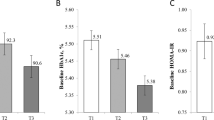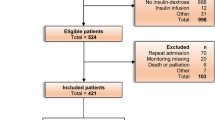Abstract
BACKGROUND: In circulating lymphocytes of individuals with insulin resistance and overt hyperglycaemia (NIDDM patients), alterations, affecting pyruvate dehydrogenase (PDH), the key enzyme in glucose oxidative breakdown, have been observed. They include below normal enzyme activity and, in vitro, no enzyme response to insulin at low physiological levels (5 µU/ml) as well as activation up to the basal values of controls with insulin at high physiological levels (50 µU/ml), instead of activation and inhibition respectively, as in controls.
OBJECTIVE: To investigate whether these alterations characterize circulating lymphocytes of individuals with insulin resistance in whom derangements of glucose homeostasis are absent (obese subjects with normal glucose tolerance), or present but still controllable (nonobese and obese newly diagnosed NIDDM patients on an appropriate diet).
SUBJECTS: Thirty obese subjects (BMI 36±3) responding normally to an oral glucose tolerance (OGT) test; 60 newly diagnosed NIDDM patients (30 nonobese, BMI 22±4 and 30 obese, BMI 38±2); 30 nonobese (BMI 21±5) and nondiabetic subjects, with no family history for NIDDM, served as controls.
METHODS: Evaluation of PDH activity in circulating lymphocytes before and after exposure to insulin at 5 and 50 µU/ml, and of clinical parameters before and during an OGT test.
RESULTS: 1) In circulating lymphocytes of obese nondiabetic subjects as well as obese and nonobese newly diagnosed NIDDM patients, PDH activity was significantly below normal. In vitro, enzyme response to insulin at 5 µU/ml was reduced in nonobese NIDDM patients with respect to controls, and absent in obese nondiabetic subjects and obese NIDDM patients. Enzyme response to insulin at 50 µU/ml was reversed in all individuals, which allowed enzyme activity to recover up to the basal level of controls. 2) In NIDDM patients and obese nondiabetic subjects, undergoing an OGT test, the area under the glycaemic curve (g-AUC) was as expected; the area under the insulinaemic curve (i-AUC) was increased in both groups with respect to controls, but significantly only in the latter.
CONCLUSION: In individuals with insulin resistance PDH activity in their circulating lymphocytes rises up to basal levels of controls, only if these cells are exposed to insulin at high physiological concentrations, and g-AUC is normal only in those subjects who have significantly increased i-AUC. This suggests that with insulin at sufficiently high concentrations both parameters can be corrected. We conclude that the derangements responsible for the alterations of the two parameters share common features and thus the described PDH alterations in circulating lymphocytes reflect systemic insulin resistance whether accompanied by hyperglycaemia or not.
Similar content being viewed by others
Article PDF
Author information
Authors and Affiliations
Corresponding author
Rights and permissions
About this article
Cite this article
Curto, M., Novi, R., Rabbone, I. et al. Insulin resistance in obese subjects and newly diagnosed NIDDM patients and derangements of pyruvate dehydrogenase in their circulating lymphocytes. Int J Obes 21, 1137–1142 (1997). https://doi.org/10.1038/sj.ijo.0800527
Received:
Revised:
Accepted:
Issue date:
DOI: https://doi.org/10.1038/sj.ijo.0800527
Keywords
This article is cited by
-
Pregnancy induces molecular alterations reflecting impaired insulin control over glucose oxidative pathways that only in women with a family history of Type 2 diabetes last beyond pregnancy
Journal of Endocrinological Investigation (2009)
-
Down-regulation of Pyruvate Dehydrogenase Phosphatase in Obese Subjects is a Defect that Signals Insulin Resistance
Obesity Research (2005)
-
In obese individuals dexfenfluramine corrects molecular derangements reflecting insulin resistance
International Journal of Obesity (2000)
-
Derangements of pyruvate dehydrogenase in circulating lymphocytes of NIDDM patients and their healthy offspring
Journal of Endocrinological Investigation (1999)



